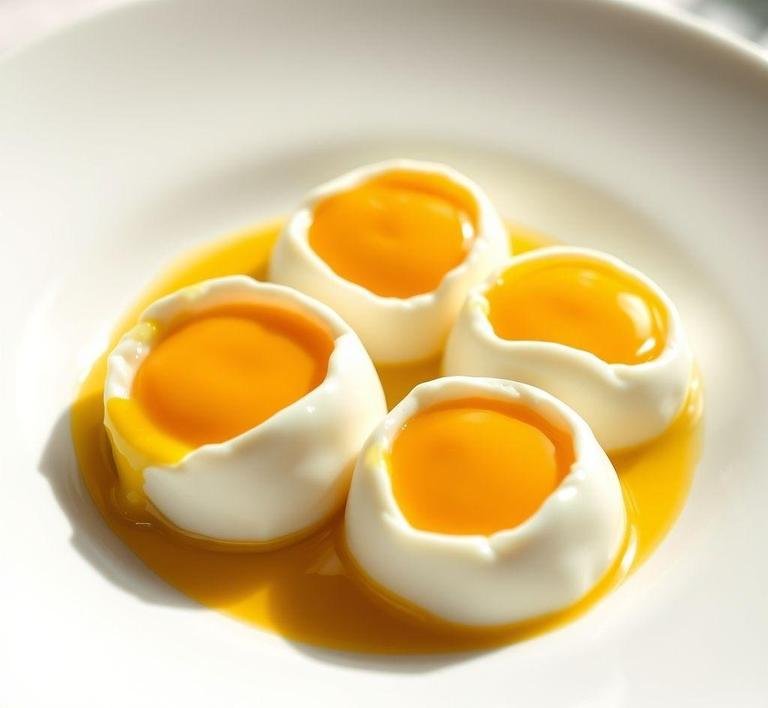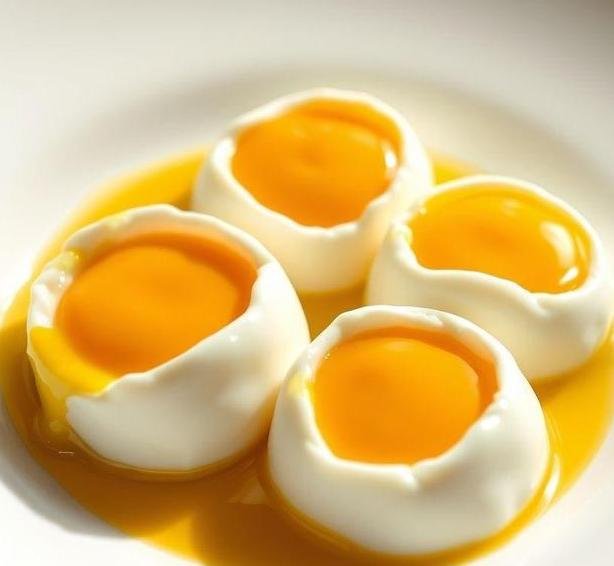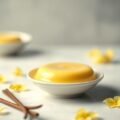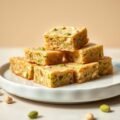Mary Berry’s Perfect Poached Eggs are a quintessential British breakfast dish, carefully crafted to produce eggs with tender whites and runny, velvety yolks. Poaching eggs is an art that Mary Berry has mastered, combining her culinary expertise with a keen understanding of texture and taste. The eggs, when poached correctly, are delicately set around the yolk, offering the perfect balance of softness and slight firmness. Mary Berry’s recipe for poached eggs elevates this simple dish into something you might expect to find in a fine-dining restaurant. Her version is an ideal choice for breakfast, brunch, or even a light lunch, served with a slice of buttered toast, or as part of a more elaborate plate.
One of the key aspects of Mary’s poached eggs is the attention to detail in the process. She ensures that the eggs cook gently, allowing the whites to wrap around the yolk without breaking. The technique involves using just the right temperature of water and a controlled poaching time. Through her approach, she guarantees consistently perfect results, with the eggs retaining their beautiful form and silky consistency.
Mary Berry’s Perfect Poached Eggs Recipe
Ingredients Needed

To make Mary Berry’s Perfect Poached Eggs, you’ll need just a few simple ingredients, but each one plays a crucial role in creating the perfect poached egg:
- Fresh Eggs – The fresher the eggs, the better your poaching results will be. Fresh eggs have tighter whites, which helps them stay together while poaching, ensuring that the whites don’t disperse into the water. Mary Berry advises using free-range or organic eggs for the best quality.
- Water – You need a large, deep pan of water for the poaching process. It should be at a gentle simmer (not a rolling boil), as too much heat will cause the eggs to break apart and overcook.
- Vinegar (optional) – Some people add a little white vinegar to the water, which helps to set the egg whites quickly, ensuring they don’t spread out too much. While this is optional in Mary’s recipe, it can make the process a bit easier for beginners.
- Salt – A pinch of salt to season the eggs once they’re done, bringing out their natural flavors.
- Butter or Olive Oil (optional) – For greasing the pan or for serving the eggs, a little bit of butter or a drizzle of olive oil can enhance the richness of the dish.
Equipment Needed
Mary Berry’s poached eggs recipe doesn’t require any fancy equipment, but a few essential tools will make the process much smoother and more effective:
- Large, Shallow Pan – A wide pan allows the eggs to float freely in the water, giving them plenty of room to poach evenly without crowding. The shallowness of the pan also makes it easier to control the temperature of the water.
- Slotted Spoon – A slotted spoon is crucial for gently lifting the eggs out of the water once they’ve finished cooking. It allows any excess water to drain away before serving.
- Timer or Clock – To ensure that the eggs cook perfectly, timing is essential. A timer will help you keep track of the poaching process, typically around 3-4 minutes for a soft poached egg.
- Small Bowls or Cups – For cracking each egg before adding it to the water. This allows you to gently slide the egg into the pan without breaking the yolk.
- Paper Towels or a Clean Towel – For draining the poached eggs and ensuring that excess water is removed before serving.
Instructions To Make Mary Berry’s Perfect Poached Eggs
Now that you have all the ingredients and equipment ready, let’s dive into the step-by-step instructions to create Mary Berry’s Perfect Poached Eggs.
- Prepare the Water: Begin by filling a large, shallow pan with water. Add about 2-3 inches of water to ensure that the eggs can float comfortably. Heat the water over medium heat until it reaches a gentle simmer. You should see small bubbles forming at the bottom, but it shouldn’t be boiling. You want a temperature of about 180°F (82°C).
- Add Vinegar (Optional): If you’re using vinegar, add a teaspoon of white vinegar to the water. This helps to set the egg whites and prevents them from spreading too much. Don’t worry, you won’t taste the vinegar in the finished egg.
- Crack the Eggs: Crack each egg into a small bowl or cup. This ensures that the yolk stays intact and that you can easily slide the egg into the water. Do this one at a time, as adding multiple eggs at once can cause them to crowd in the pan and prevent even cooking.
- Create a Whirlpool (Optional): Some cooks like to create a small whirlpool in the water by stirring it gently with a spoon. This can help the egg whites wrap around the yolk, though it’s not essential if you’re aiming for a more traditional poach.
- Add the Eggs to the Water: Gently slide the eggs into the simmering water. You can do this by lowering the bowl close to the water’s surface and letting the egg slip in slowly. Avoid dropping the egg from too high, as this can cause it to break apart.
- Poach the Eggs: Let the eggs cook in the simmering water for about 3 to 4 minutes for a soft poached egg. The egg whites should be set but the yolk should remain soft and runny. If you prefer your yolks firmer, you can leave them in the water for an extra minute or so.
- Remove the Eggs: Use a slotted spoon to carefully lift the eggs from the water. Allow any excess water to drain off. If desired, you can place the eggs on a plate lined with paper towels to soak up any remaining moisture.
- Serve: Season the eggs with a pinch of salt and a crack of black pepper. Serve them on toasted bread, or enjoy them on their own for a light and healthy breakfast or brunch.
Tips And Tricks
- Fresh Eggs Are Key: The fresher your eggs, the better your poached eggs will turn out. Fresh eggs have thicker whites that stay together in the water, creating a neat and tidy poached egg.
- Use the Right Water Temperature: It’s essential to have a gentle simmer, not a rolling boil. Too much heat will cause the eggs to break apart, while too little heat will result in undercooked eggs.
- Don’t Overcrowd the Pan: If you’re making multiple poached eggs, cook them one or two at a time to avoid overcrowding. This ensures each egg gets enough space to cook evenly.
- Timing is Crucial: The key to perfect poached eggs is getting the timing right. Use a timer or watch the clock closely. For a soft yolk, aim for 3 to 4 minutes of cooking.
- Rest Before Serving: If you’re cooking poached eggs in advance, you can store them in a bowl of cold water in the fridge. When ready to serve, gently reheat them in simmering water for 30 seconds to a minute.
Mary Berry’s Perfect Poached Eggs are a testament to the beauty of simple ingredients and classic techniques. With just a few key steps-using fresh eggs, controlling the water temperature, and being mindful of timing-you can create eggs that are perfectly poached every time. Whether you’re making them for a casual breakfast or as part of a more elaborate brunch spread, these eggs are sure to impress. Follow Mary’s tips, and you’ll be well on your way to mastering the delicate art of poaching eggs, transforming this humble dish into a culinary masterpiece.
Easy Recipe Variations For Mary Berry’s Perfect Poached Eggs

Mary Berry’s perfect poached eggs are a thing of quiet beauty-delicate, silky whites cocooning a rich, golden yolk. But what makes this dish endlessly captivating is its versatility. While the base recipe is straightforward, variations allow you to tailor it to your mood, pantry, or culinary ambition.
1. Herb-Infused Elegance
To elevate the flavor of your poached eggs without overwhelming their delicate nature, try infusing the poaching water with fresh herbs like thyme, dill, or tarragon. The herbs subtly perfume the egg as it cooks, giving it a sophisticated depth.
Tip: Tie the herbs into a small bundle with kitchen twine and let them simmer in the water for five minutes before adding your eggs.
2. Spice It Up
Poached eggs are the perfect canvas for a bit of heat. Consider sprinkling the finished egg with smoked paprika, Aleppo pepper, or even a few chili flakes. Want more heat? A dollop of harissa or chili oil on top brings smoky, spicy complexity.
3. Cheesy Dreams
Who can say no to cheese? Once the eggs are poached, place them gently on a warm slice of sourdough, and then top with grated Parmesan, crumbled feta, or even a whisper of blue cheese. A brief pass under the broiler can create a bubbly, melty crown that’s impossible to resist.
4. The Avocado Affair
For a modern brunch favorite, pair Mary Berry’s poached eggs with smashed avocado on toast. Add lime juice, crushed red pepper, and a hint of garlic to the avocado for a punchy contrast to the egg’s richness. Garnish with microgreens for that Instagram-worthy finish.
5. Global Flavors
Take your eggs around the world:
- Italian: Top with pesto and sun-dried tomatoes.
- Middle Eastern: Add a base of hummus or labneh, then drizzle with za’atar-spiced olive oil.
- Japanese: Serve with steamed rice, a splash of soy sauce, and a sprinkle of furikake.
Storing Leftovers
Now, let’s be honest-poached eggs are best enjoyed fresh. That magical moment when the yolk gently oozes is fleeting. But if you’ve made a few too many, there’s still hope!
Short-Term Storage
Poached eggs can be stored for up to 2 days in the refrigerator, but only if you follow a few crucial steps:
- Cool Them Quickly: Transfer the eggs immediately from the poaching water into a bowl of ice water. This stops the cooking process and preserves the texture.
- Refrigerate in Water: Keep the eggs submerged in cold water in an airtight container. This prevents them from drying out or developing a rubbery texture.
Reheating Without Ruining Them
To reheat, warm a pot of water to just below simmering (around 160-170°F or 70-75°C). Gently slide in the poached egg and heat for about 30 to 45 seconds, just enough to warm it through without cooking it further.
Never microwave poached eggs! The delicate balance of the whites and yolk can be easily destroyed, and you may end up with an unpleasant texture-or worse, an egg explosion.
What To Eat With Mary Berry’s Perfect Poached Eggs?
This is where things get really exciting. A poached egg is more than a breakfast dish-it’s the star of your plate, ready to be dressed up for brunch, lunch, or even a light supper.
Classic Companions
- Buttered Toast or English Muffins: Crisp edges, soft insides-the perfect vehicle to sop up that golden yolk.
- Wilted Spinach or Sautéed Kale: Add some garlicky greens for a nourishing, earthy base.
- Grilled Asparagus or Roasted Tomatoes: Their natural sweetness and acidity complement the egg’s richness beautifully.
Gourmet Twists
- Smoked Salmon and Crème Fraîche: This luxurious combo adds a tangy, silky depth, perfect for a brunch that feels like a treat.
- Prosciutto or Pancetta: A salty, savory accent that pairs wonderfully with the mildness of poached eggs.
- Mushroom Ragout: Earthy, meaty mushrooms in a light cream sauce create a comforting pairing that feels restaurant-worthy.
Whole Meal Inspiration
- Eggs Benedict: Take it all the way with toasted muffins, ham, poached eggs, and a generous ladle of Hollandaise sauce.
- Grain Bowls: Layer quinoa or farro with roasted veggies, avocado, and a poached egg for a hearty yet wholesome meal.
- Savory Oatmeal: Top creamy oats with a poached egg, sautéed greens, and maybe a drizzle of soy or sesame oil for a comforting, savory breakfast.
Conclusion
Mary Berry’s perfect poached eggs are more than a recipe-they’re a canvas for creativity, comfort, and culinary joy. Whether you stick to the traditional approach or experiment with global flavors and textures, poached eggs offer endless versatility. By understanding how to vary the recipe, store leftovers with care, and pair your eggs thoughtfully, you elevate a simple dish into something truly special.
So next time you crack an egg into that gentle swirl of simmering water, know that you’re not just cooking-you’re crafting a moment. Whether it’s for a cozy breakfast alone or an elegant brunch with friends, these poached beauties never fail to impress.
FAQs
What Is The Secret To Making Mary Berry’s Poached Eggs Perfect?
Mary Berry recommends using fresh eggs, which make a huge difference in the outcome. The key is to create a gentle simmer in the water-this helps the egg whites to set without breaking apart. Additionally, adding a splash of vinegar to the water helps the egg whites coagulate more quickly, ensuring a neat and tidy poached egg.
Can I Poach Multiple Eggs At Once Using Mary Berry’s Method?
Yes, you can poach multiple eggs, but it’s important to avoid overcrowding the pan. Mary Berry suggests poaching one egg at a time in a shallow pan, keeping the water at a gentle simmer. If you need to poach several, it’s best to use a larger pan with plenty of space for the eggs to float freely and cook evenly.
How Long Should I Cook Mary Berry’s Poached Eggs For The Perfect Consistency?
For perfectly poached eggs with a runny yolk, cook them for about 3 to 4 minutes. If you prefer a firmer yolk, cook them for an additional minute or two. Keep an eye on the eggs during cooking, as the simmering water will help the whites set around the yolk while leaving the center soft and gooey.


